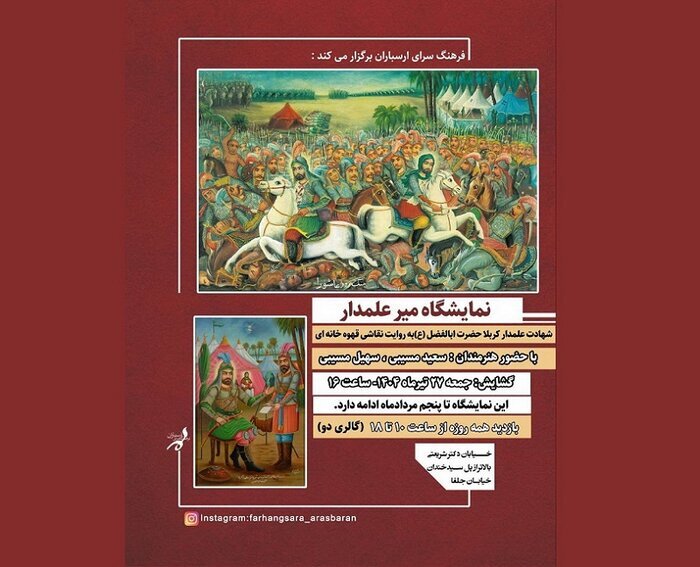Tehran exhibition honors Hazrat Abbas (AS)through Ghahve-Khaneh paintings

TEHRAN – The “Mir-e Alamdar” exhibition, centered on Hazrat Abbas (AS), the brother of Imam Hussein (AS) and the standard-bearer of the Imam's group during the battle of Ashura in 680, inaugurated in Tehran’s Arasbaran Cultural Center on Friday.
The five-day exhibition features traditional Ghahve-Khaneh paintings by Iranian artists Saeid and Soheil Mosayyebi, IRNA reported on Saturday.
The artworks depict stories rooted in the artists' imagination, created with oil paints, narrating the eternal struggle between good and evil, illustrating the heroic sacrifices, epic battles, and the innocence of revered religious figures and national heroes, the report added.
The statement of the exhibition reads: “Coinciding with the month of Muharram, my father, esteemed artist Saeid Mosayyebi, and I, Soheil Mosayyebi, have decided to honor the memory of the Ghahve-Khaneh painters—those imaginative artists whose works mirror the beliefs and emotions of our people. We aim to continue their legacy, pay tribute to the martyrs of Karbala, and depict scenes of heroism and sacrifice through our brushes—stories of the tragedy of Karbala, centered on the martyrdom of Hazrat Abbas (AS).”
The exhibition will be running until July 27.
Ghahve-Khaneh paintings are a unique form of Iranian folk-narrative painting that emerged in the 19th century. The term "Ghahve-Khaneh" translates to "coffee house" in Persian, as these paintings were predominantly displayed in traditional Iranian coffee houses.
Ghahve-Khaneh paintings are characterized by their vibrant colors, intricate details, and narrative storytelling. They often depict scenes from Iranian folklore, epic tales, historical events, and everyday life. These paintings were primarily created by itinerant artists who traveled from one coffee house to another, displaying their artworks to entertain and engage the patrons.
One distinct feature of Ghahve-Khaneh paintings is their narrative structure. The artists used a sequential storytelling approach, presenting a series of interconnected scenes within a single painting. This technique allowed viewers to follow the story from one scene to another, creating a sense of visual storytelling akin to a comic strip or a storyboard.
The subject matter of Ghahve-Khaneh paintings is diverse and reflects the cultural, social, and historical contexts of Iran. It encompasses a wide range of themes, including love stories, mythological legends, religious narratives, historical events, and social commentaries. These paintings often highlight traditional Iranian values, customs, and beliefs, serving as a visual representation of the collective memory and cultural identity of the Iranian people.
In terms of artistic style, Ghahve-Khaneh paintings combine elements of traditional Persian miniature painting, popular art, and storytelling traditions. The artists employed intricate detailing, rich color palettes, and stylized figures to create visually captivating compositions. The use of bold lines, exaggerated proportions, and expressive gestures adds a dynamic and lively quality to the paintings.
Ghahve-Khaneh paintings not only served as a form of entertainment but also provided a medium for social and political commentary. The artists often incorporated subtle satirical elements and allegorical symbolism to critique societal norms, political events, and the power dynamics of the time. These paintings acted as a means of communication, reflecting the aspirations, concerns, and aspirations of the Iranian people.
While Ghahve-Khaneh paintings were primarily displayed in coffee houses, they have gained recognition as an important part of Iranian cultural heritage. Today, they are appreciated as unique examples of folk art and serve as a visual window into the traditions, stories, and artistic expressions of the past. Efforts have been made to preserve and promote Ghahve-Khaneh paintings, ensuring their continued appreciation and understanding for future generations.
SAB/
Leave a Comment